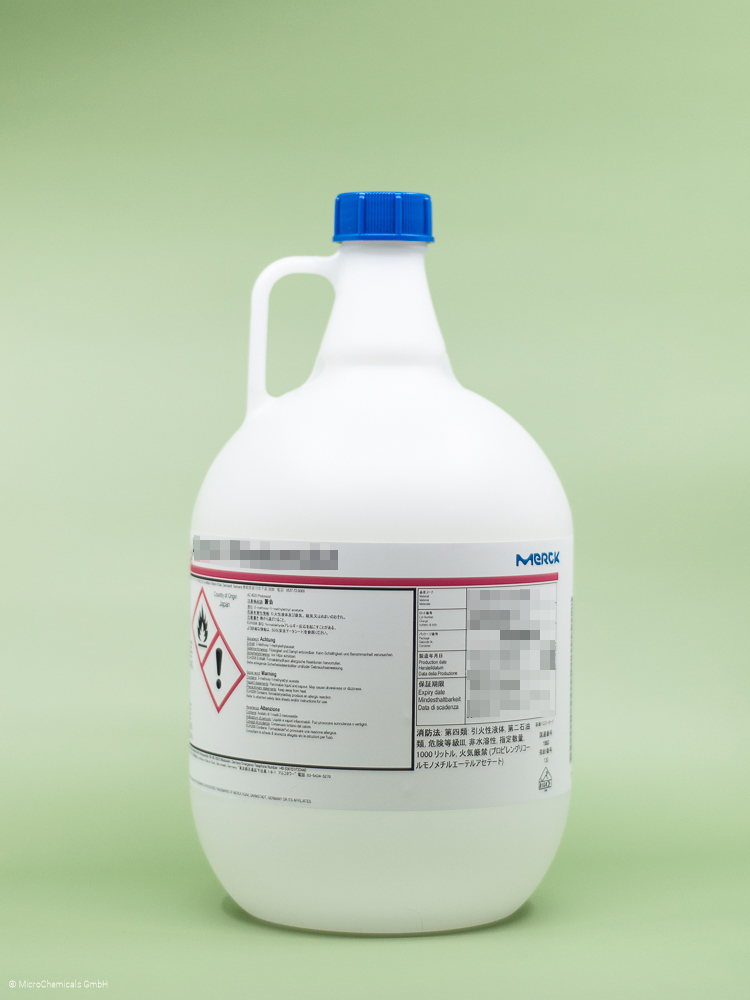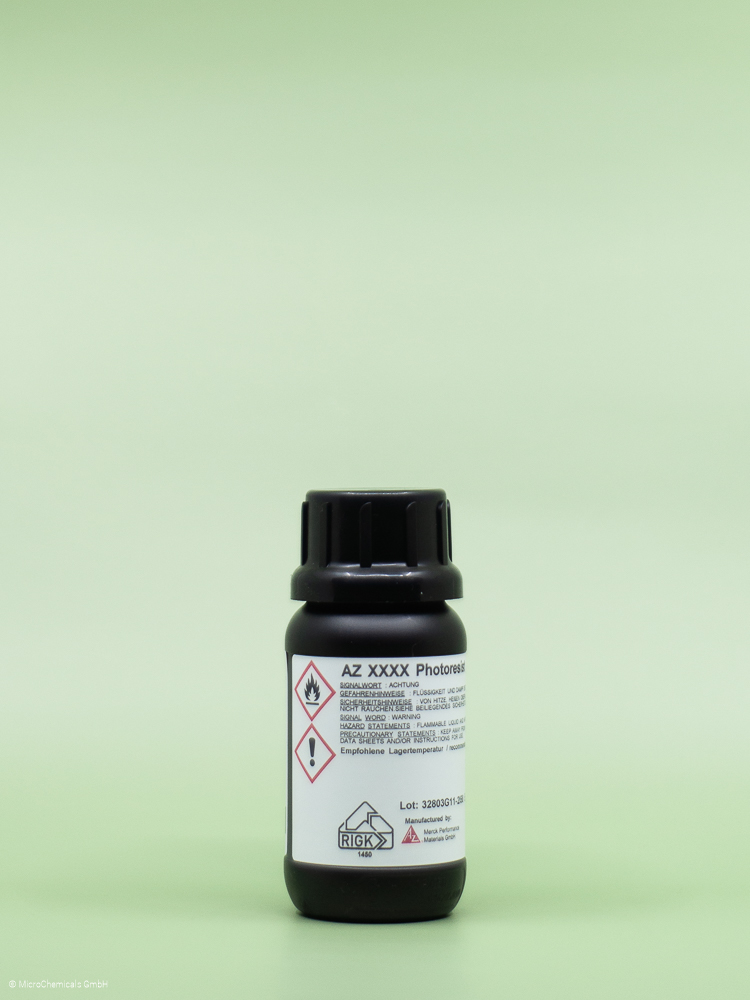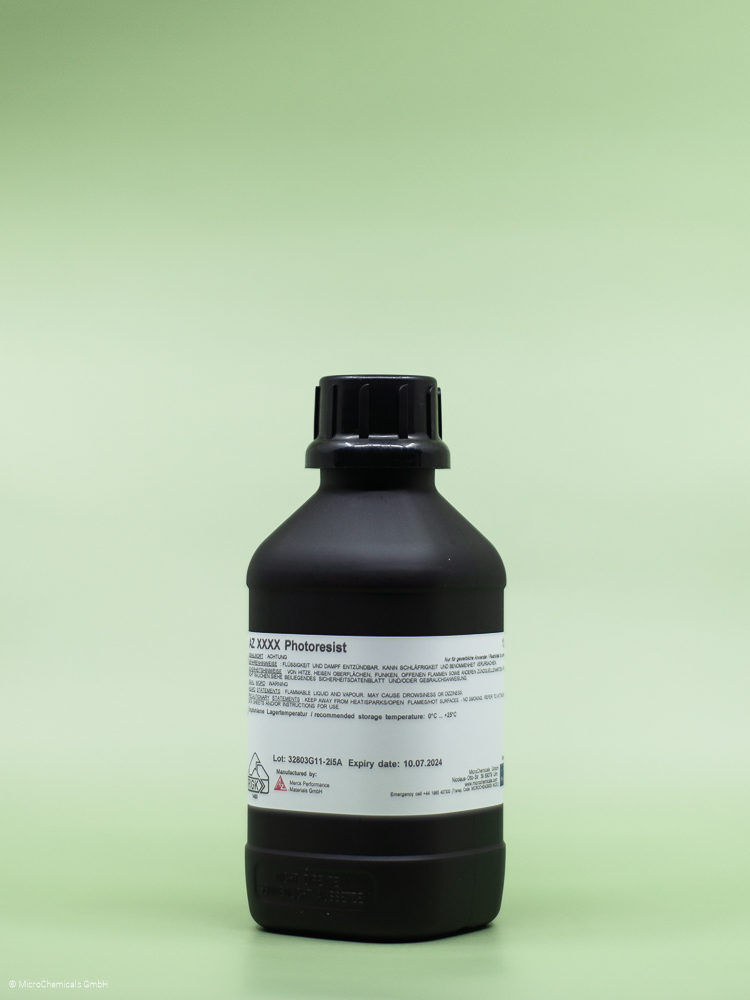Image Reversal Resist
Filter
–
AZ 5209-E Photoresist - 3.785 l
1A005209
AZ® 5209E
Image Reversal Resist for High Resolution
General Information
This special photoresist is the thinner version of the AZ® 5200E series intended for lift-off techniques which call for a negative side wall profile. The reversal bake moderately cross-links the exposed resist making the developed structures thermally stable up to approx. 130°C. Due to the comparably low resist film thickness of ~ 0.9 µm, the process parameter window for an undercut is rather small thus requiring some optimizations in the exposure dose and the reversal bake parameters. Therefore, if the resolution required is not in the sub-µm range, a thicker resist such as the AZ® LNR-003 (next section), or the AZ® nLOF 2000 negative resists might be a good alternative.
Product Properties
Very high resolution as a positive resist as well as a negative resist
Possible negative sidewall profile in image reversal mode
Compatible with all common developers (NaOH-, KOH- or TMAH-based)
Compatible with all common strippers (e. g. with AZ® 100 Remover, organic solvents, or aqueous alkaline)
h- and i-line sensitive (approx. 320 - 405 nm)
Resist film thickness range approx. 0.7 - 1.2 µm
High thermal stability especially in image reversal mode
Developers
If metal ion containing developers can be used, the NaOH-based AZ® 351B in a 1:4 dilution (for a required resolution < 1 µm 1:5 dilution recommended) is a suited developer.
The KOH-based AZ® 400K (also 1:4 - 1:5 diluted) is also possible.
If metal ion free developers have to be used, we recommend the TMAH-based AZ® 726 MIF or AZ® 326 MIF developer, normally undiluted, or - for maximum resolution - moderately 3:1 - 2:1 (3 parts Developer :1 part of DI-Water) diluted with water.
Removers
For non cross-linked resist films the AZ® 100 Remover, DMSO or other common organic solvents cab be used as stripper. If the resist film is crosslinked (e. g. by high temperature steps > 140°C, during plasma processes such as dry etching, or during ion implantation), we recommend the NMP-free TechniStrip P1316 as remover. AZ® 920 Remover can be a good choice as well, in case of harsh treated, hard to remove resist residuals.
Thinning/ Edge Bead Removal
We recommend for thinning and edge bead removal the products AZ® EBR Solvent or PGMEA.
Further Information
MSDS:
Safety Data Sheet AZ® 5209-E Photoresist english
Sicherheitsdatenblatt AZ® 5209-E Fotolack german
TDS:
Technical Data Sheet AZ® 5209-E Photoresist english
Application Notes:
Further Information about Photoresist Processing
AZ 5214-E Photoresist - 3.785 l
1005214EJP
Bottle size:
3.785 l
AZ® 5214E
Image Reversal Resist for High Resolution
General Information
This special photoresist is intended for lift-off techniques which call for a negative side wall profile. The reversal bake moderately cross-links the exposed resist making the developed structures thermally stable up to approx. 130°C. Due to the comparably low resist film thickness of ~1.4 µm, the process parameter window for an undercut is rather small thus requiring some optimizations in the exposure dose and the reversal bake parameters. Therefore, if the resolution required is not in the sub-µm range, a thicker resist such as the AZ® LNR-003 (next section), or the AZ® nLOF 2000 negative resists might be a good alternative.
The undercut of AZ® 5214E attained under optimized process parameters.
Product Properties
Very high resolution as a positive resist as well as a negative resist
Possible negative sidewall profile in image reversal mode
Compatible with all common developers (NaOH-, KOH- or TMAH-based)
Compatible with all common strippers (e. g. with AZ® 100 Remover, organic solvents, or aqueous alkaline)
h- and i-line sensitive (approx. 320 - 405 nm)
Resist film thickness range approx. 1.0 – 1.8 µm
High thermal stability especially in image reversal mode
Developers
If metal ion containing developers can be used, the NaOH-based AZ® 351B in a 1:4 dilution (for a required resolution < 1 µm 1:5 dilution recommended) is a suited developer.
The KOH-based AZ® 400K (also 1:4 - 1:5 diluted) is also possible.
If metal ion free developers have to be used, we recommend the TMAH-based AZ® 726 MIF or AZ® 326 MIF developer, normally undiluted, or - for maximum resolution - moderately 3:1 - 2:1 ( 3 parts Developer :1 part of DI-Water) diluted with water.
Removers
For non cross-linked resist films the AZ® 100 Remover, DMSO or other common organic solvents cab be used as stripper. If the resist film is crosslinked (e. g. by high temperature steps > 140°C, during plasma processes such as dry etching, or during ion implantation), we recommend the NMP-free TechniStrip P1316 as remover. AZ® 920 Remover can be a good choice as well, in case of harsh treated, hard to remove resist residuals.
Thinning/ Edge Bead Removal
We recommend for thinning and edge bead removal the products AZ® EBR Solvent or PGMEA.
Further Information
MSDS:
Safety Data Sheet AZ® 5214E Photoresist english
Sicherheitsdatenblatt AZ® 5214E Fotolack german
TDS:
Technical Data Sheet AZ® 5214E Photoresist english
Application Notes:
Further Information about Photoresist Processing
TI 35 E - 5.00 l
1035005
Bottle size:
5.00 l
TI 35E Photoresist
Image Reversal Resist
General Information
TI 35E for 2.5 - 5 µm Resist Film Thickness (g -, H - and I-line)
TI 35E is an image reversal resist with optimised adhesion, however compared with TI 35ESX, a lower sof¬tening temperature. As a result it is more suited for wet-chemical etching processes.
Product Properties
Optimized resist adhesion to all common substrate materials
Broad process parameter window for stable and reproducible litho-processes
Compatible with all common strippers (e. g. with AZ® 100 Remover, organic solvents, or aqueous alkaline)
g-, h- and i-line sensitive (approx. 320 - 440 nm)
Resist film thickness range approx. 2.5 - 5 µm
Developers
If metal ion containing developers can be used, the KOH-based AZ® 400K in a 1:4 dilution (for higher resist film thicknesses 1:3.5 - 1:3 diluted possible) is a suited developer.
If metal ion free developers have to be used, we recommend the TMAH-based AZ® 2026 MIF developer (undiluted).
Removers
For non cross-linked resist films the AZ® 100 Remover, DMSO or other common organic solvents cab be used as stripper. If the resist film is crosslinked (e. g. by high temperature steps > 140°C, during plasma processes such as dry etching, or during ion implantation), we recommend the NMP-free TechniStrip P1316 as remover. AZ® 920 Remover can be a good choice as well, in case of harsh treated, hard to remove resist residuals.
Thinning/ Edge Bead Removal
We recommend for thinning and edge bead removal the products AZ® EBR Solvent or PGMEA.
Further Information
MSDS:
Safety Data Sheet TI 35E Photoresist english
Sicherheitsdatenblatt TI 35E Fotolack german
TDS:
Technical Data Sheet TI 35E Photoresist english
Application Notes:
Further Information about Photoresist Processing
TI 35 ESX - 5.00 l
1035005X
Bottle size:
5.00 l
TI 35ESX Photoresist
Image Reversal Resist
General Information
The TI 35 ESX resist is specially designed for the application in the so called “image reversal technology” for:
Subsequent lift-off of deposited layers with a thickness up to 4 µm
Plasma etching
The viscosity of the resist leads to a thickness range depending on the spin speed from 2.5 - 3.5 µm. The typical aspect ratio of the structured features achievable is in the range of 1.0 - 2.0. This technical data sheet intends to give you a guide-line for process parameters for various applications. However, the optimum values for e.g. spin profile, exposure dose or development depend on the individual equipment and need to be adjusted on each individual demand.
Due to the required second exposure, the process sequence will be easier with a negative resist like **AZ® nLof 20xx series and could be a good alternative.
Product Properties
Possible negative sidewall profile in image reversal mode
Compatible with all common developers (NaOH-, KOH- or TMAH-based)
Compatible with all common strippers (e. g. with AZ® 100 Remover, organic solvents, or aqueous alkaline)
g-, h- und i-line sensitive (approx. 320 - 440 nm)
Resist film thickness range approx. 2.5 – 3.5 µm
Developers
We recommend the TMAH-based developers AZ® 726 MIF, AZ® 2026 MIF or AZ® 400K 1:4 based on buffered KOH.
Removers
For non cross-linked resist films the AZ® 100 Remover, DMSO or other common organic solvents cab be used as stripper. If the resist film is crosslinked (e. g. by high temperature steps > 140°C, during plasma processes such as dry etching, or during ion implantation), we recommend the NMP-free TechniStrip P1316 as remover. AZ® 920 Remover can be a good choice as well, in case of harsh treated, hard to remove resist residuals.
Thinning/ Edge Bead Removal
We recommend for thinning and edge bead removal the products AZ® EBR Solvent or PGMEA.
Further Information
MSDS:
Safety Data Sheet TI 35ESX Photoresist english
Sicherheitsdatenblatt TI 35ESX Fotolack german
TDS:
Technical Data Sheet TI 35ESX Photoresist english
Application Notes:
Further Information about Photoresist Processing
TI Spray - 0.25 l
1030010
Bottle size:
0.25 l
TI Spray
Image Reversal Resist
General Information
TI Spray for 1 - 20 µm Resist Film Thickness (g -, H - and I-line)
TI Spray is a ready-to-use spray resist whose low content of low-boiling solvent allows a smooth resist surface at the expense of a somewhat smaller edge coverage by slow drying of the resist film formed (If edge coverage is of highest importance, the use of AZ® 4999 should be considered as a good alternative).
It can be used in positive or in image-reversal (negative) mode. It can be used for wet chemical etching processes as well as for lift off applications.
Product Properties
Optimized resist adhesion to all common substrate materials
Broad process parameter window for stable and reproducible litho-processes
Compatible with all common strippers (e. g. with AZ® 100 Remover, organic solvents or aqueous alkaline)
g-, h- and i-line sensitive (approx. 320 - 440 nm)
Resist film thickness range approx. 1 - 20 µm
Very smooth resist layers after spray coating on the price of lower edge coverage potential
Developers
If metal ion containing developers can be used, the KOH-based AZ® 400K in a 1:4 dilution (for higher resist film thicknesses 1:3.5 - 1:3 diluted possible) is a suited developer.
If metal ion free developers have to be used, we recommend the TMAH-based AZ® 2026 MIF developer (undiluted).
Removers
For non cross-linked resist films the AZ® 100 Remover, DMSO or other common organic solvents cab be used as stripper. If the resist film is crosslinked (e. g. by high temperature steps > 140°C, during plasma processes such as dry etching, or during ion implantation), we recommend the NMP-free TechniStrip P1316 as remover. AZ® 920 Remover can be a good choice as well, in case of harsh treated, hard to remove resist residuals.
Thinning/ Edge Bead Removal
We recommend for thinning and edge bead removal the products AZ® EBR Solvent or PGMEA.
Further Information
MSDS:
Safety Data Sheet TI Spray english
Sicherheitsdatenblatt TI Spray german
TDS:
Technical Data Sheet TI Spray english
Application Notes:
Further Information about Photoresist Processing
TI XLiftX - 1.00 l
108001X
Bottle size:
1.00 l
TI xLift-X
Image Reversal Resist
General Information
TI XLift-X allows resist thicknesses up to over 10 µm. However, as the resist thickness increases, the process becomes ever more time-consuming for rehydration or for the out gassing of the nitrogen formed during exposure. Thus a reasonable alternative for most applications would be the AZ® nLOF 2070 negative resist.
10.5 µm thick metal finger via lift-off with TI xLift-X
Product Properties
Possible negative sidewall profile in image reversal mode
Compatible with all common developers (NaOH-, KOH- or TMAH-based)
Compatible with all common strippers (e. g. with AZ® 100 Remover, organic solvents, or aqueous alkaline)
g-, h- und i-line sensitive (approx. 320 - 440 nm)
Resist film thickness range approx. 4 – 25 µm
Developers
We recommend the KOH-based AZ® 400K 1:3 - 1:4 diluted.
If metal ion free developers have to be used, we recommend the TMAH-based AZ® 2026 MIF developer.
Removers
For non cross-linked resist films the AZ® 100 Remover, DMSO or other common organic solvents cab be used as stripper. If the resist film is crosslinked (e. g. by high temperature steps > 140°C, during plasma processes such as dry etching, or during ion implantation), we recommend the NMP-free TechniStrip P1316 as remover. AZ® 920 Remover can be a good choice as well, in case of harsh treated, hard to remove resist residuals.
Thinning/ Edge Bead Removal
We recommend for thinning and edge bead removal the products AZ® EBR Solvent or PGMEA.
Further Information
MSDS:
Safety Data Sheet TI xLift-X english
Sicherheitsdatenblatt TI xLift-X german
TDS:
Technical Data Sheet TI xLift-X english
Application Notes:
Further Information about Photoresist Processing












